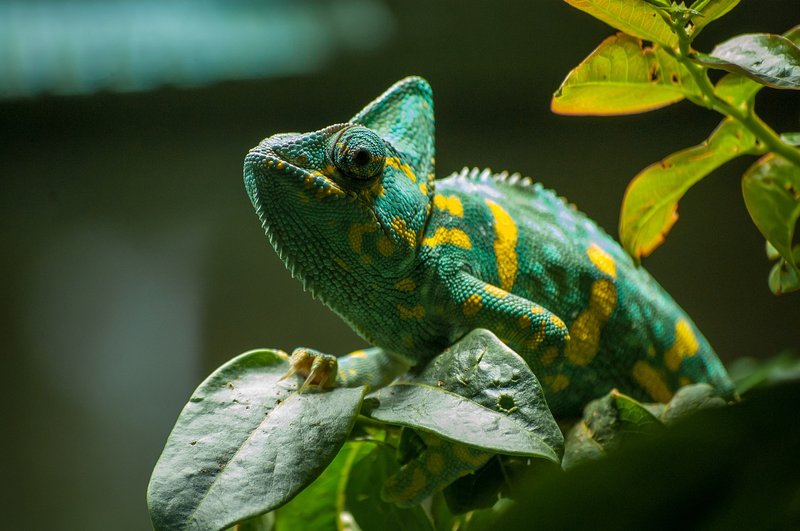
Chameleons may look tough with their colorful skins and impressive camouflage, but they can be prone to a variety of health problems. These issues can stem from factors like diet, habitat conditions, and even some inherent traits of the species themselves. Getting to know these potential hiccups is essential for any chameleon owner. So grab a cup of coffee, and let’s get into the nitty-gritty of keeping your Parson’s friend healthy and happy.
1. Metabolic Bone Disease (MBD)
Metabolic bone disease, or MBD, is one of the most common health issues faced by Parson’s chameleons. This condition usually arises due to a lack of calcium or an imbalance in calcium and phosphorus levels in their diet. Just like humans need a good intake of calcium to keep bones strong, chameleons need it too!
If your chameleon isn’t getting enough UVB lighting or calcium supplements, they might develop MBD. You might notice signs like lethargy, swollen limbs, or even a curved spine. It’s a serious condition that can lead to more severe problems if left untreated. Here’s the thing: proper lighting, like UVB bulbs, can make a world of difference. Make sure your chameleon has access to natural sunlight or a quality UVB light for about 10-12 hours a day, and dust their food with calcium powder regularly.
To sum it up, keeping an eye on their diet and lighting is crucial for preventing MBD. If you spot the early signs, don’t wait! Consult a vet who specializes in reptiles. Catching it early can make treatment much easier.
2. Respiratory Infections
Respiratory infections can sneak up on chameleons, especially if their habitat isn’t properly maintained. Just like us, chameleons can catch colds—only theirs can be much more serious. Poor humidity levels, drafts, and dirty enclosures can contribute to these infections. If your chameleon starts to wheeze, cough, or has difficulty breathing, it’s time to take action.
A well-maintained environment is key here. Make sure your chameleon’s habitat has appropriate humidity levels (around 50% to 70%) and avoid any stressors like loud noises or sudden temperature changes. You might consider investing in a hygrometer to monitor humidity levels accurately.
If you suspect your Parson’s chameleon has a respiratory infection, visiting a vet promptly is critical. Treatment often involves antibiotics, but only a professional can prescribe the right one. Remember, the sooner you tackle the issue, the better the chances for a full recovery.
3. Dehydration
Chameleons are unique in that they often don’t drink from bowls like other pets. Instead, they prefer droplets of water, which mimic rain. If you notice your Parson’s chameleon becoming lethargic or its eyes appearing sunken—these could be signs of dehydration. You have to keep them hydrated to stay vibrant and healthy.
To prevent dehydration, mist their enclosure regularly to create a humid environment. You might want to invest in a misting system for more convenience. Additionally, ensure you’re offering a balanced diet of gut-loaded insects and leafy greens that can help increase water intake.
You can also help rehydrate your chameleon by carefully offering water droplets or using a syringe if necessary. But be cautious! Chameleons can be sensitive to handling, so go slowly to avoid stressing them out.
4. Parasitic Infections
Parasitic infections can be a hidden threat for Parson’s chameleons. Internal parasites can come from contaminated food sources or unclean habitats and can cause serious digestive issues. If your chameleon is experiencing weight loss, diarrhea, or a bloated appearance, it might be time to consider the possibility of parasites.
Regularly check for signs of parasites and keep their habitat clean. A clean enclosure reduces the risk of infections. Additionally, it’s a good practice to have a fecal test done by a vet if your chameleon shows any health issues.
If parasites are confirmed, don’t panic! Your veterinarian can prescribe treatments that are effective and safe for your chameleon. Just be sure to follow their instructions closely for the best results.
5. Eye Problems
Eye problems can be another common issue for Parson’s chameleons. You might notice signs like squinting, swelling, or cloudy eyes. Often, these issues can arise from environmental stressors such as dry air, improper lighting, or even nutritional deficiencies.
To keep your chameleon’s eyes in top shape, make sure they’re getting enough UVB light and that their enclosure has proper humidity. A comfortable environment can often prevent these eye problems from developing. Regularly cleaning their habitat and ensuring that they have access to clean water droplets can also help.
If you observe any eye issues, visiting a vet is vital. They may need to prescribe eye drops or recommend adjustments in their care routine to prevent further complications.
6. Stress and Behavioral Issues
Chameleons can be quite sensitive to their surroundings. Stress is often a hidden problem that can lead to a range of health issues, from lethargy to loss of appetite. Changes in their habitat, sudden movements, or even overcrowding can contribute to anxiety in these creatures.
Creating a calming habitat is essential for your Parson’s chameleon. Ensure they have plenty of hiding spots like foliage and branches where they can retreat when feeling threatened. Avoid excessive handling unless necessary, and be mindful of noise levels in their environment.
If you notice your chameleon hiding more than usual or exhibiting erratic behaviors, consider making adjustments to their habitat to reduce stress. Sometimes, even a small change can create a more serene environment and help them feel more at home.
7. Skin Issues
Skin problems can also pop up in Parson’s chameleons. If you see shedding difficulties, dry skin, or, in more serious cases, open wounds, these could signal underlying health issues. A lack of humidity or improper nutrition can often lead to skin problems, as chameleons rely on their skin to help with hydration and health.
To prevent skin issues, keep humidity levels high and offer a balanced diet rich in nutrients. Regular misting can also aid in proper shedding. If shedding becomes a problem, it’s a good idea to provide a humidity box filled with damp moss or substrate.
If your chameleon does develop skin lesions or shows signs of festering wounds, make sure to consult a vet. Early intervention can lead to quicker healing and a happier chameleon.
8. Conclusion
Caring for a Parson’s chameleon can be an enriching experience, but it does come with its challenges. By being aware of the common health issues like metabolic bone disease, respiratory infections, and more, you can create a supportive environment for your scaly friend. It’s all about understanding their unique needs and staying proactive.
Remember, keeping an eye on their habitat, diet, and overall behavior is crucial. If you notice any unusual signs, don’t hesitate to reach out to a vet who specializes in reptiles. Just like tending to that delicate garden, a little bit of care and attention can ensure your Parson’s chameleon’s health and happiness for years to come. So, nurture your little buddy, and you’ll be rewarded with a colorful companion full of life!

